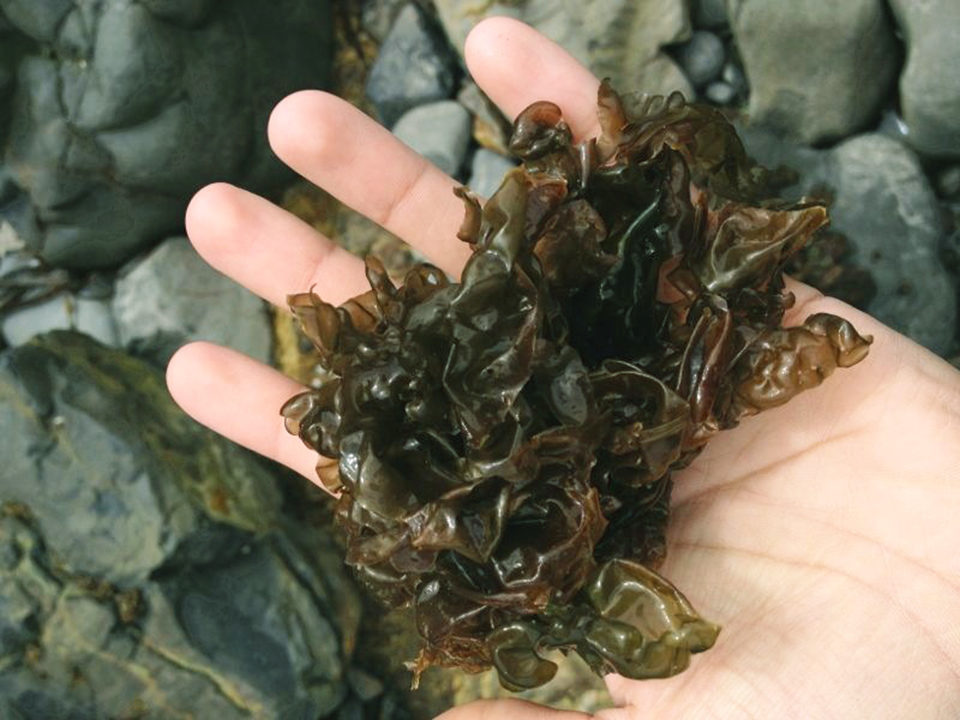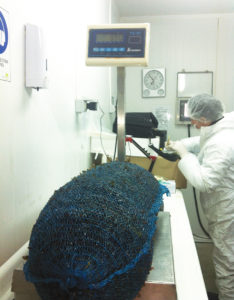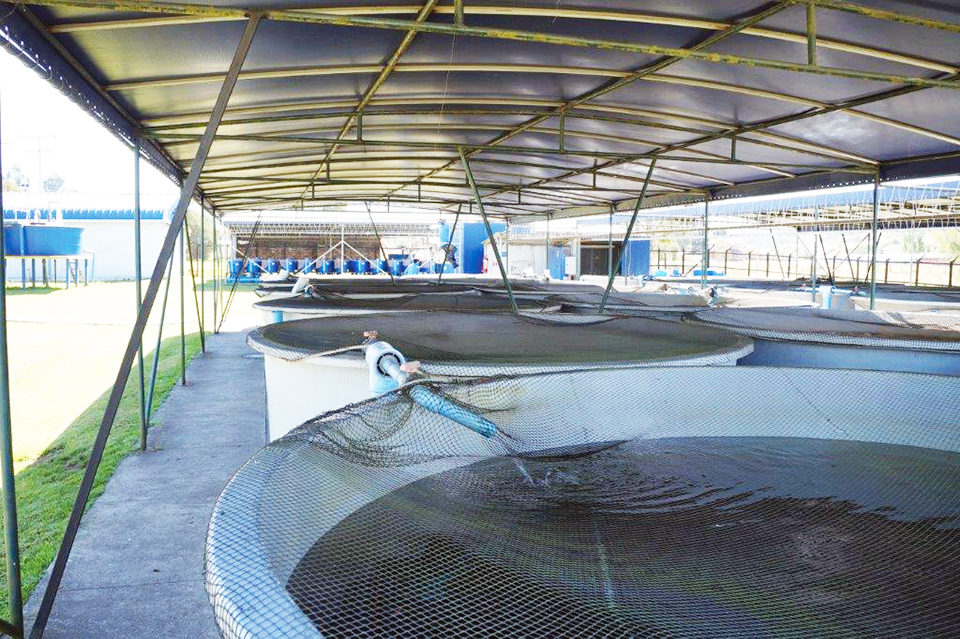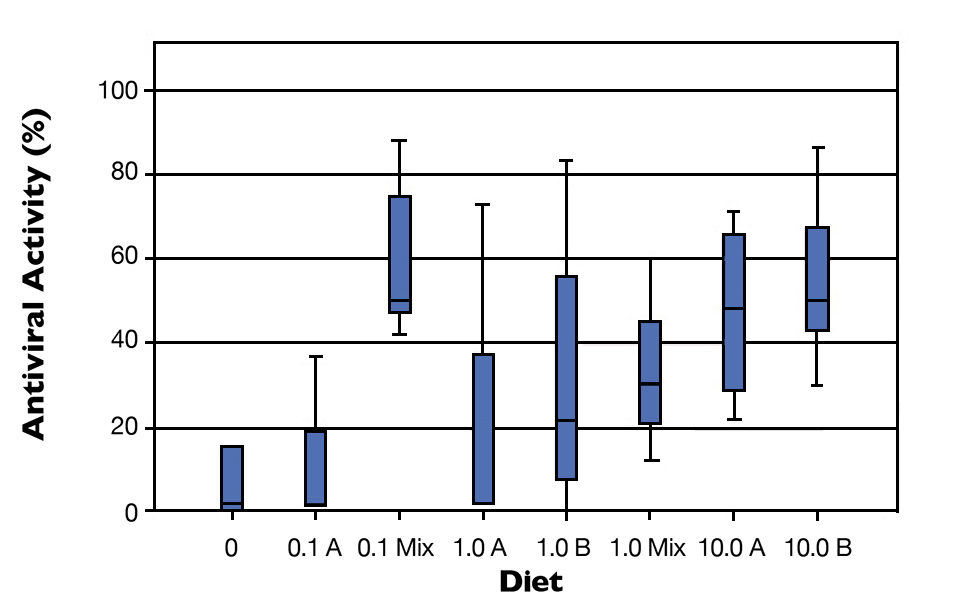Inclusion in the diets provided good growth and antiviral protection

The outbreak of infectious salmon anemia (ISA) in Chile resulted in the loss of some U.S. $5 million for the salmon production sector from 2007 to 2009, as well as a 75 percent reduction in the production of Atlantic salmon (Salmo salar). In response, the Chilean government and the salmon industry applied a series of measures to control and eradicate the disease. However, ISA and the potential emergence of new diseases continue to be problems for salmon production in Chile and other producing countries.
Infectious salmon anemia is caused by a virus of the Orthomyxoviridae family. In its clinical stage, the disease affects cultivated Atlantic salmon in their seawater stage. However, the disease has not been described in wild Atlantic salmon, even though the aquatic environment naturally hosts high concentrations of pathogens, including the ISA virus. This indicates that natural factors allow wild salmon to remain in good health.
Seaweed traits
The effects of diet on animals’ immune systems are well known, in particular in relation to disease resistance in fish. Both macronutrients and micronutrients can affect responses to pathogens such as viruses. Functional diets that include bioactive ingredients have been shown to increase disease resistance while also increasing growth and feeding, making them a powerful tool to prevent diseases. Among the dietary options is the use of seaweed.
One of the most important characteristics of marine seaweed is its capacity to absorb and concentrate mineral salts, vitamins, oligo-elements and amino acids, which they use to meet metabolic needs. Because of this, marine seaweed is considered a major reservoir of natural molecules. Given this capacity to concentrate nutrients, seaweed is an important food source, although its nutritional composition varies by species, geographic location and harvesting season.
Red seaweed or rhodophyta (Phylum rhodophyta) is considered a much more important source of biologically active metabolites than other types of seaweed. Its bioactive content includes sulfated polysaccharides, Vitamin C, amino acids, peptides, fatty acids and proteins. Among the bioactive proteins are two important groups: lectines and phycobiliproteins. The latter are found only in cyanobacteria and red algae.
Given the above, red seaweed is a potential source of antiviral components for fish. The unique nutritional properties of red seaweed include high levels of protein, and the seaweed can be cultured in a sustainable and environmentally friendly manner.
ISA study design

The authors performed a study to assess a strategy of using natural ingredients that form part of the first trophic level as part of the diet of Atlantic salmon in the marine phase in a strategy to combat the effects of the ISA virus. The impacts of the diet were assessed by an ex vivo protocol following the in vivo application of the diet to Salmo salar.
The Chilean red seaweed species selected for the experiment were Pyropia columbina, which has a high protein content throughout the year (25.20 percent crude protein in winter) and Gracilaria chilensis, which has the second-highest protein content (24.31 percent in winter) among Chile’s red seaweeds. Both species are accessible in Chile through natural banks and by cultivation. G. chilensis is cultivated commercially in Regions I, III, IV, VII and X, while Pyropia columbina is cultivated in Region X.
The red seaweed used in this study was harvested in the area of Ancud, Chiloe Island, in southern Chile in the winter of 2012. Immediately after harvesting, the algae were taken to the city of Calbuco, Chile, to be freeze dried.
Lyophilized concentrates of both species were prepared and added to a commercial diet. Diets were prepared with 0.1, 1.0 and 10.0 percent Gracilaria chilensis and Pyropia columbina separately, and 0.1 and 1.0 percent of a mix of both species at a 1:1 ratio. The experimental diets were extruded into 3.0-mm pellets.
The diets were fed twice a day to satiation for eight weeks to eight triplicate groups of 18 Atlantic salmon at the BioMar Chile outdoor tank facilities on the island of Chiloe in southern Chile. The initial average body weight of the fish was 149.05 ± 32.00 g.
Data on production parameters and blood samples were collected at two, four and eight weeks. Serum and its constituents were challenged with ISA virus in the presence of salmon kidney cells under controlled laboratory conditions. Antiviral activity against ISAV was evaluated through a plaque reduction assay.
Results
Nutritional characterization
The amino acid profiles showed interesting values for taurine in the freeze-dried samples from fish fed both Pyropia columbina (0.99 percent) and Gracilaria chilensis (1.06 percent) compared to levels in fishmeal (0.69 percent) and rapeseed meal (0.06 percent), the latter two produced in Chile. This was a very promising result, considering the other plant sources for fish feed are deficient in taurine, an important amino acid involved in anti-inflammatory responses in fish, as well as a powerful antioxidant that protects fish against oxidative tissue damage.
The levels of arachidonic acid (ARA), an omega-6 fatty acid, in fish fed Pyropia columbina (10.88 percent) and Gracilaria chilensis (9.63 percent) were about five times as high as the 1.91 percent level in fishmeal produced in Chile. This was very promising, given that the presence of this fatty acid in fish results in higher rates of growth and survival.
ARA and ARA/eicosapentaenoic acid levels increase significantly in Atlantic salmon during smoltification. Fish with higher ARA content in gill phospholipids adapt better to the conditions and challenges of saltwater. Considering that fish have a limited capacity to synthesize ARA, the amino acid needs to be provided in their diets.
Fish performance
The growing performance of experimental fish was not negatively affected by the inclusion of red seaweeds in the experimental diets. In fact, a considerable improvement was observed in fish performance in some cases, such as the diet with 10 percent Gracilaria chilensis (1.50 ± 0.12), which resulted in a higher specific growth rate than that of the control diet (0.92 ± 0.01), as shown in Fig. 1.

A = Pyropia columbina
B = Gracilaria chilensis
0 = control diet

Anti-ISAv activity
After completing the challenge protocol to ISAv with cell monolayers in the presence of salmon sera from fish fed diets with red seaweed, lysis plaques generated by the virus were obtained by incubation and counted. Control samples were obtained from fish fed diets without red seaweed. No antiviral effects were detected in the control samples.
In contrast, the sera of fish fed the diets with red seaweed had significantly higher levels of antiviral activity against ISAv – 0.013 (P <0.05) – as compared to the sera of positive control fish. The serum of fish fed diets with 0.1 percent seaweed mix (55.73 ± 19.63 percent) and 10.00 percent of Gracilaria chilensis (48.52 ± 5.05 percent) showed the greatest increase in antiviral activity compared to the control diet (4.12 ± 9.45 percent) (Figure 2).

A = Pyropia columbina
B = Gracilaria chilensis
0 = control diet
The test results showed that red seaweeds increased the capacity of Salmo salar to resist the ISAv pathogen by 55.73 ± 19.63 percent.
Perspectives
Compared to serum from the control fish group, serum from fish fed diets supplemented with red seaweed showed a significant increase in anti-ISAv activity. This could explain why symptoms of infectious salmon anemia have been identified in farm-raised salmon and not in wild-caught salmon.
The inclusion of the Chilean red seaweed species Pyropia columbina and Gracilaria chilensis in the diets of Salmo salar provided two main benefits: good growth and antiviral protection. Both seaweed species can be farmed, so their use could be an excellent strategy to help ensure the sustainability of Chilean salmon farming.
(Editor’s Note: This article was originally published in the May/June 2014 print edition of the Global Aquaculture Advocate.)
Authors
-
Ivonne Lozano, Ph.D.
Laboratorio de Genética y Biotecnología en Acuicultura
Facultad de Ciencias Agronómicas
Universidad de Chile
Santa Rosa 11315
La Pintana, Santiago, Chile -
Jaime Carrasco C., M.S.
BioMar Chile S.A.
R & D Salmon Division
Puerto Montt, Chile -
Jurij M. Wacyk, Ph.D.
Laboratorio de Nutrición, Producción Animal
Facultad de Ciencias Agronómicas
Universidad de Chile
Santiago, Chile -
Marcelo A. Cortez-San Martín, Ph.D.
Laboratorio de Virología Molecular
Centro de Biotecnología Acuícola
Facultad de Química y Biotecnología Acuícola
Facultad de Química y Biología
Universidad de Santiago de Chile
Santiago, Chile
Tagged With
Related Posts

Responsibility
A look at various intensive shrimp farming systems in Asia
The impact of diseases led some Asian shrimp farming countries to develop biofloc and recirculation aquaculture system (RAS) production technologies. Treating incoming water for culture operations and wastewater treatment are biosecurity measures for disease prevention and control.

Intelligence
An emerging shellfish farming industry in Namibia
For shellfish farming in Namibia to continue expanding, industry must better comply with approved sanitation standards. The Namibian Shellfish Monitoring and Sanitation Program, currently in development, will help.

Innovation & Investment
Aquaculture in Canada: status, perspectives
Canada exports farmed seafood products to more than 22 countries and is the main seafood supplier to the U.S. market. Finfish, primarily salmon, production is strong and shellfish production is growing, but diversification will be imperative to maintain competitiveness.

Responsibility
Can sustainable mariculture match agriculture’s output?
Global, sustainable mariculture production, developed on a massive, sustainable scale and using just a small fraction of the world’s oceanic areas, could eventually match the output of land-based agriculture production. Scale and international law considerations require the involvement of many stakeholders, including national governments and international organizations.


